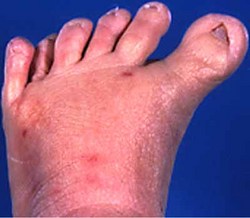Foot, Postaxial Polydactyly of
Definition:

Foot, Postaxial Polydactyly of
Objective: Presence of a supernumerary digit that is not a hallux
Comments: Although it is appealing to believe in many cases that the supernumerary (non-hallux) digit is the most fibular, there may be no evidence for this. When the digit is de minimus, this seems reasonable by parsimony. When it is fully formed, associated with a supernumerary metatarsal, and fully functional, it may be impossible to determine which toe is supernumerary. Nevertheless, the designation as postaxial is reasonable given the tradition of this designation. Postaxial polydactyly has been divided into two types: A (a fully formed digit) and B (digitus minimus, or a pedunculated, non-articulating, non-functional appendage). We recognize these subtypes but note that post-axial polydactyly actually represents a spectrum from type A to type B. When the type is indeterminate, no subtype is specified. The term uses the word postaxial instead of the embryologic posterior because the former is established in clinical medicine.
Synonyms:
Replaces: - Posterior Duplication of the Limb/Foot
- Fibular Polydactyly
COMMENTS (0) | Add Comment









